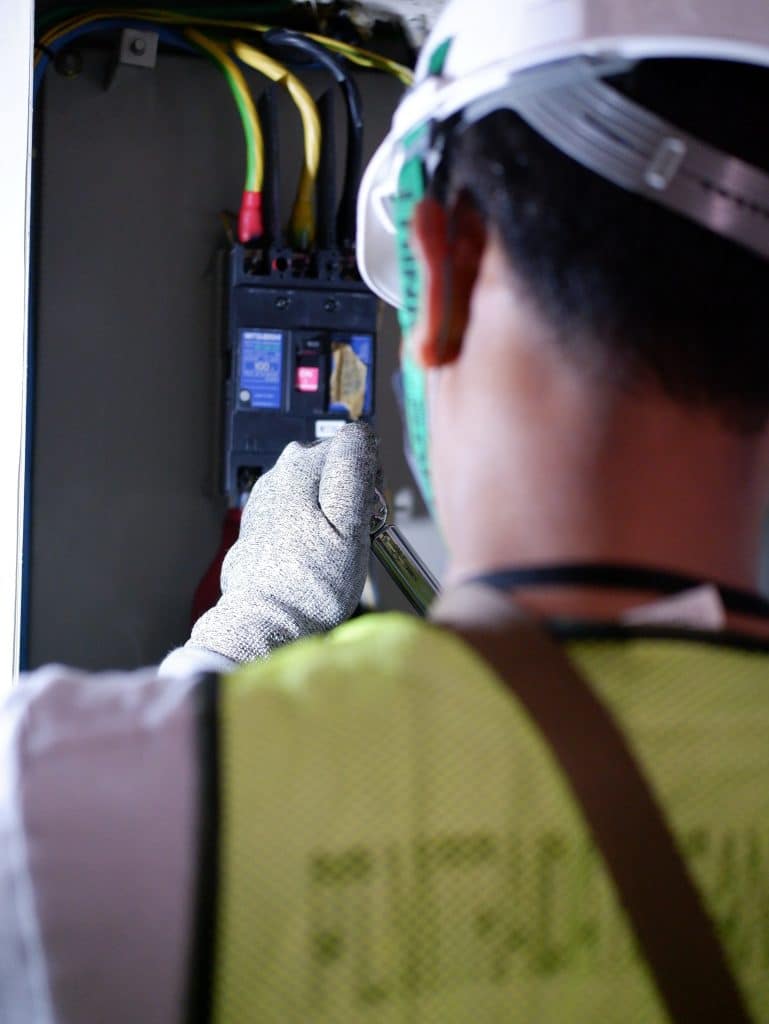The circuit breaker fault current rating must be properly sized, which is one of the most crucial safety factors to take into account when building an electrical circuit (commonly called the kA rating). However, not everyone is well-versed in circuit breaker ka rating. If this idea, which is also one of the most typical design errors in electrical circuits, is still unclear to you, scroll down to learn more about the kA rating.
What is kA stands for in electrical?
Electric current is measured using the kiloampere (kA) unit. One kiloampere is equal to 1,000 amperes, which is the electrical current equal to the flow of one coulomb per second. A multiple of the ampere, the SI base unit for electric current, is the kiloampere. “Kilo” serves as the prefix for 103 in the metric system. Sometimes a kiloampere is also referred to as a kiloamp. Kiloamperes can be expressed as kA; for instance, 1 kA can be used to represent one kiloampere.
What Does The kA Rating On A Circuit Breaker Mean?
The kA rating of a circuit breaker is one of the most vital elements when talking about electrical systems and branch circuits. This “kA rating” is often referred to as the breaking capacity, and highlights the maximum short-circuit current that can be interrupted by the breaker safely. This is vital when it comes to the reliability and protection of the electrical system.
Furthermore, another key factor in designing and analyzing system voltage is the ‘r ratio’. The maximum short circuit current value that a circuit breaker may break at a specific voltage and phase angle is indicated by the kA rating on the circuit breaker. The circuit breaker may be destroyed and rendered unusable if the current flowing through it surpasses this value.

Importance of kA Rating
Every circuit breaker is rated in kA. KA here stands for kilo ampere. The ultimate breaking capacity of circuit breakers or short circuit withstands capacity are other names for kA rating. The circuit breaker may be harmed if the short circuit current value exceeds the rated kA.
A short circuit, for example, causes the circuit to carry a lot more current than it was intended to. A circuit that was intended to draw no more than 20A suddenly can consume hundreds or even thousands of amps. If this happens, the circuit breaker will trip.
Hence, by shutting down the malfunctioning circuit while ensuring that other circuits continue to operate normally, the circuit breaker, therefore, must safeguard the installation from problems. Indeed, the circuit breaker’s kA (kilo ampere) rating is crucial. Depending on the circuit, a short circuit can result in a different maximum current flow through the circuit.
To prevent danger, it is vital to determine in advance the proper size of the circuit breaker (CB) ka rating. An improper kA rating can occasionally result in death and provide a risk of causing a fire. To prevent such risks, the proper circuit breaker ka rating must be used.
Circuit Breaker Ratings and Its Specification
A circuit breaker is an electrical device that automatically opens the circuit without causing harm to itself when a predefined current overload is reached. It can open and close a circuit manually as well. Technically, circuit breakers protect the electrical circuits. A circuit breaker’s performance is typically determined by its ratings and specifications. This implies that you can safeguard yourself from electrical issues by being aware of the common circuit breaker values.
The reliability of circuit breakers can be ensured by getting a test certificate. This certificate is documented proof that the circuit breaker has gone through several tests and meets the required performance standards.
The nameplate on the device itself contains the circuit breaker rating. The voltage rating, frequency rating, current rating, and other information may be listed on this nameplate. Below is its individual description.
Voltage Rating
The highest RMS voltage (Root Mean Squared) for which a circuit breaker was designed is referred to as the voltage rating. On its nameplate, some circuit breakers list multiple voltages. Finding the highest voltage on the list will reveal the breaker’s real voltage rating.
Frequency Rating
A circuit breaker’s operating frequency is specified by its frequency rating. Ordinarily, standard circuit breaker sizes are rated for 50 Hz or 60 Hz, with DC or direct current usage being rare. Using a circuit breaker outside of its operational range may raise the temperature within the appliance and harm it.
Continuous Current Rating
The maximum continuous current that a circuit breaker can handle while still operating normally is known as the continuous current rating. This rating represents the thermal design of the breaker in that the device cannot rise above the permitted temperature increase.
Breaking Capacity
The symmetrical and asymmetrical are varieties of breaking capacity. Each has distinctive qualities.
- Symmetrical breaking capacity
The circuit breaker’s symmetrical current and voltage recovery are determined by its symmetrical breaking capacity. When the breaker contacts separate, it is the maximum RMS amount of an AC component of a short circuit current.
- Asymmetrical breaking capacity
The circuit breaker’s asymmetrical current and voltage recovery are determined by its asymmetrical breaking capacity. The total AC and DC components of a short circuit current at the instant the breaker contacts separate are referred to as the RMS amount. In comparison to the symmetric breaking current, the asymmetric one is stronger.
Making Capacity
A circuit breaker’s making capacity is the greatest current it can carry when closed. The short circuits covered by this specification occur while the breaker contacts are closed.
Operating Sequence
The speed at which circuit breakers can open and close in a certain amount of time is referred to as their rated working sequence. O-0.3s-C0-15s-CO and O-0.3s-CO-3 minutes-CO are frequent sequences.
Short-Circuit Current Rating
The highest RMS current that a circuit breaker can carry without suffering external damage is known as the short circuit current rating (SCCR). Usually, this measurement is given in kA (kiloampere). SCCRs are helpful in assessing an item’s safety against fault currents. These measures are needed for many machineries in industrial zones, including elevators, motors, and air conditioners.
Short Circuit Withstand Capacity
The highest current that a power circuit breaker can accept instantly on a short circuit without failing is referred to as the short circuit withstand capacity, sometimes known as the ultimate breaking capacity (or kA). The incorrect use of a kA rating might result in fatal fires.

How Do You Select a Breaker kA Rating?
The most typical short circuit and excessive current protection is a circuit breaker. It is a simple electrical device that works with electromagnetic force, yet safety depends on it greatly. What the current rating of the breaker will be to safeguard devices during abnormal conditions securely is the most frequently asked question.
Plus, addressing transient recovery voltage is necessary to make the circuit breakers function. This occurs when a circuit breaker interrupts a fault and leads to a temporary increase in voltage. For this, engineers have to analyze and design circuit breakers (like the case circuit breaker) to manage the transient recovery voltage. This becomes especially vital in a commercial RCD and LV system.
There are other factors to take into account while choosing a circuit breaker. Make sure that you are consulting a qualified electrician before choosing and installing a circuit breaker. Here are some suggestions for choosing a circuit breaker.
Typical Breaker Current Rating Setting
The typical trip current should be taken into account when choosing a circuit breaker. When we use the word “typical,” we mean nominal circumstances. It is commonly assumed that the ambient temperature is between 20 and 25 degrees Celsius. Additionally, it will relate to the typical level of voltages in the circuit without taking into account the impact of any tolerances.
Voltage Rating
The voltage rating of breakers also has safety implications. A circuit breaker can safely trip under any fault circumstance, thanks to its rating. The breaker voltage rating needs to be at least as high as the open circuit voltage, if not higher. Contacts may arc or explode if the voltage rating is low, especially if there is a short circuit.
Operating Temperature
Temperature control is crucial. The breaker must be able to take 50C at the very least if the target maximum ambient temperature where it will be used is 50C. The breaker must, however, be rated to at least minus 30C if the application’s minimum ambient temperature is minus 30. If this condition is not met, the breaker may trip early or after the scheduled time.
Can Immediately Detect Ground Faults
A ground fault circuit interrupter is not a feature of a standard circuit breaker (GFCI). GFCI will provide further defense against ground faults. The typical trip level for a ground fault with a GFCI is up to 30mA. Since the current is at a safe level, people are guaranteed to be safe from electrocution.
Short Circuit Current Rating or Interrupting Capacity (unit in kAIC)
The interrupting rating, also known as the short circuit current rating, is a crucial factor when choosing a reliable circuit breaker. The breaker can safely interrupt this amount of short circuit current under specific test conditions.
How do you find the kA rating of a circuit?
There is a certain amperage for each circuit breaker, in amount of current. The circuit breaker itself has a label indicating this number or grade. Most domestic circuits are commonly rated at 15 amps or 20 amps. It is critical to remember that circuit breakers are only capable of handling roughly 80% of their total amperage. Thus, a 20-amp circuit breaker can withstand roughly 16 amps, compared to a 15-amp circuit breaker’s capacity of about 12 amps.
Here are the steps on how you can find the kA rating of a circuit:
Step 1: Find the breaker for the electrical equipment you are using first (This is normally either a 15-amp or 20-amp circuit).
Step 2: Multiply the amperage by 0.8. This is so that a circuit breakers don’t operate at more than 80% of their maximum amperage. Failure to do so could result in math errors or, worse yet, electrical fires!
Step 3: Determine the circuit’s total amperage requirements for ALL the devices you intend to connect.
What kA rating should I use?
Choosing a circuit breaker depends on its electrical requirements rated to perform a specific function in each application. Choosing a circuit breaker is properly necessary for the efficient and safe operation of the electrical apparatus.
You may even require a supplement sb breaker in some cases. Supplement sb breakers are another circuit breaker type of device that is built to comply with UL 1077.
In order to identify the appropriate kA rating to be used, consider the following:
- Electrical characteristics of the installation for which the CB is meant (AC or DC, Voltage, etc.)
- Its surroundings include the temperature outside, within a kiosk or switchboard, the weather, etc.
- Short-circuit current assumed at the installation
- Site characteristics of the busbar trunking system, shielded cables, and busbars
- Coordination with an upstream or downstream device, such as a switch disconnector or contactor, cascading, or selectivity.
- Operational requirements: necessary or optional remote control and indicator contacts, relevant auxiliary tripping coils, and connection
- Installation guidelines, in particular: heat and electric shock protection (See Protection against electric shocks and electrical fires)
What is the maximum rating of the circuit breaker?
Generally, circuit breakers are evaluated based on their capacity to open the protected circuit when a particular quantity of electricity is flowing through the circuit after being tested. AIC ratings for circuit breakers commonly range from 5,000 to 200,000 AIC.
Final Thoughts!
When building a circuit, it’s crucial to take safety factors like a circuit breaker’s kA rating into account. A significant accident is likely to happen without it.
Hence, always be cautious and take the kA ratings into account when designing. It is best to consult or at least look at a circuit breaker sizing chart if you are unclear about what device to utilize in your application.
Furthermore, the region you are purchasing the circuit breaker also matters. For example, In North America, adherence to a strict Privacy Policy is a fundamental aspect of business operations.
Also, for a range of excellent solutions, visit Schneider Electric, as it offers digital energy and automation options that allow everyone to make the best use of their resources and energy.













Leave a Reply